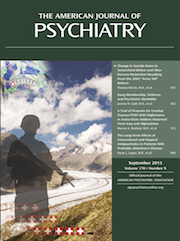New Ethical Issues for Genetic Counseling in Common Mental Disorders
Abstract
Objective
Method
Results
Conclusions
The Risk of Inheritance of Bipolar Disorder, Schizophrenia, and ASD
Copy Number Variation and Genetic Risk
| Risk (%) | |||||
|---|---|---|---|---|---|
| CNV Locus | Type | Bipolar Disorder | Schizophrenia | ASD | Risk of Any of These Disorders |
| 1q21.1 | Deletion | 7.91 | 7.91 | ||
| Duplication | 4.50 | 4.97 | 9.25 | ||
| 3q29 | Deletion | 33.56 | 33.56 | ||
| 7q11.23 | Duplication | 16.05 | 16.05 | ||
| 15q11.2 | Deletion | 2.09 | 2.09 | ||
| 15q11.2–13.1 | Duplication | 20.73 | 20.73 | ||
| 15q13.3 | Deletion | 8.76 | 5.42 | 13.70 | |
| 16p11.2 | Deletion | 5.96 | 5.96 | ||
| Duplication | 4.19 | 9.45 | 7.28 | 19.56 | |
| 17p12 | Deletion | 6.60 | 6.60 | ||
| 22q11.21 | Deletion | 26.37 | 68.25 | 23.06 | 82.01 |
| 22q11.2 | Duplication | 2.07 | 2.07 | ||
| Disease | Odds Ratio | Exposed Attributable Risk (%) | Rate of De Novo CNV If Ill (%) | Illness Risk If De Novo CNV (%)b |
|---|---|---|---|---|
| Bipolar Disorder | 4.77 | 79.0 | 4.32 | 4.45 |
| Schizophrenia | 6.27 | 84.1 | 6.10 | 5.67 |
| ASD | 7.50 | 86.7 | 7.18 | 4.07 |
| Risk of any one of these disorders | 13.53 |
Risk Prediction and Genetic Counseling
| Geneb | SNP | Marker Allele | Marker Allele Frequency | Odds Ratio | Illness Risk Given Marker (%)c |
|---|---|---|---|---|---|
| Bipolar disorder | |||||
| CACNA1C | rs4765913 | A | 0.21 | 1.13 | 1.10 |
| ODZ4 | rs12576775 | G | 0.18 | 1.18 | 1.07 |
| Schizophrenia | |||||
| VRK2 | rs2312147 | C | 0.61 | 1.09 | 1.03 |
| MHC | rs13211507 | T | 0.92 | 1.22 | 1.01 |
| NRGN | rs12807809 | T | 0.83 | 1.12 | 1.02 |
| TCF4 | rs9960767 | V | 0.056 | 1.20 | 1.18 |
Genetic Counseling for Families With Bipolar Disorder, Schizophrenia, and ASD
Prenatal Screening, Preimplantation Procedures, and Abortion
Family Members’ Rights to Genetic Information and Conflicts and Stigma Within Families
Population Screening
Genetic Tests and Marital Choice
Other Current and Future Developments
Improved Prediction
Improved Prevention and Treatment Based on Genetic Discoveries
Supplementary Material
- View/Download
- 546.39 KB
References
Information & Authors
Information
Published In
History
Authors
Funding Information
Metrics & Citations
Metrics
Citations
Export Citations
If you have the appropriate software installed, you can download article citation data to the citation manager of your choice. Simply select your manager software from the list below and click Download.
For more information or tips please see 'Downloading to a citation manager' in the Help menu.
View Options
View options
PDF/EPUB
View PDF/EPUBLogin options
Already a subscriber? Access your subscription through your login credentials or your institution for full access to this article.
Personal login Institutional Login Open Athens loginNot a subscriber?
PsychiatryOnline subscription options offer access to the DSM-5-TR® library, books, journals, CME, and patient resources. This all-in-one virtual library provides psychiatrists and mental health professionals with key resources for diagnosis, treatment, research, and professional development.
Need more help? PsychiatryOnline Customer Service may be reached by emailing [email protected] or by calling 800-368-5777 (in the U.S.) or 703-907-7322 (outside the U.S.).

